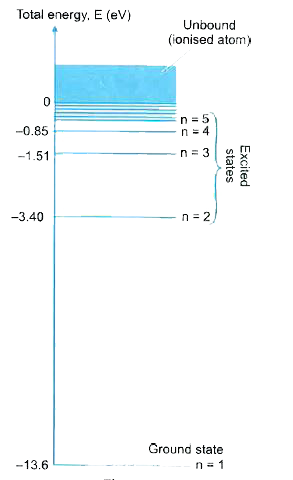Considering no electronic repulsion in Helium atom what will be Bohr's energy for both the electrons ? Bohr's energy of ground state of H− atom is −13.6eV
−13.6eV
−27.2eV
−108.8eV
−54.4eV
The correct Answer is:C
If no electronic repulsion is there than He can be treated as two mono electronic atoms so
EHe=−13.6×z2n2⇒13.6×4=−54.4eV
For both electronic system ⇒−54.4×2=−108.8eV.
Topper's Solved these Questions
- BOOK - FIITJEECHAPTER - STOICHIOMETRY AND BALANCING REDOX REACTION EXERCISE - SINGLE INTEGER ANSWER TYPE QUESTIONS5videos
STOICHIOMETRY AND BALANCING REDOX REACTION
- BOOK - FIITJEECHAPTER - THERMODYNAMICS AND THERMOCHEMISTRY EXERCISE - SINGLE INTEGER ANSWER TYPE QUESTIONS5videos
THERMODYNAMICS AND THERMOCHEMISTRY
Similar Questions
A photon of energy 12.09 eV is absorbed by an electron in ground state of a hydrogen atoms. What will be the energy level of electron ? The energy of electron in the ground state of hydrogen atom is −13.6eV
View SolutionIf the energy of an electron in the second Bohr orbit of H-atom is -E, what is the energy of the electron in the Bohr's first orbit?
View Solution
Knowledge Check
- Question 1 - Select One
The energy of the electron in the ground state of H-atom is −13.6eV. Its energy in the second orbit is
A−13.6eVB−3.4eVC−1.51eVD−0.85eV - Question 2 - Select One
The electronic energy levels of the hydrogen atom in the Bohr's theory are called
ARydberg levelsBorbitsCGround levelDorbitals - Question 3 - Select One
The energy of an electron in the nth Bohr orbit of hydrogen atom is
A−13.6n4eVB−13.6n3eVC−13.6n2 eVD−13.6n eV
Find the energy of the electrons in eV in the third Bohr orbit of the hydrogen atom.
View SolutionAn electron in Bohr's hydrogen atom has angular momentum 2hπ The energy of the electron is
View SolutionRead the pasage given below as well as the adjoining energy level diagram and then answer the questions given after the passage .
As per Bohr's theory og hydrogen atom the energy of an atom in a state corresponding to principal quantum number n is given as :
En=−13.6n2eV
The energy of an atom is the least when its electron is revolving in an orbit closets to the nucleus i.e., the one for which n =1. This state is called the ground state. When a hydrogen atom receives energy by processes such as electron collision , the atom may acquire sufficient energy to raise the electron to higher energy states and the atom is then said to be in an excited state . From these excited states the electron can then fall back to a state of lower energy , emitting a photon in the process.
The energy level diagram for the stationary states of a hydrogen atom , compouted from Bohr's relation for energy , is given in Fig.12.02. The principal quantum number n labels the stationary states in the ascending order of energy . Obviously , the highest energy corresponds to n=∞ and has an energy of 0 eV. This is the energy of the atom when the electron is completely removed (r=∞) from the nucleus and is at rest.

Now answer the follwoing questions:
How can a hydrogen atom receive energy to raise the electron to higher energy states ?View SolutionThe energy of an electron in second Bohr orbit of hydrogen atom is :
View SolutionThe energy of the electron in the ground state of H-atom is −13.6eV. The energy of the first excited state will be
View Solution

